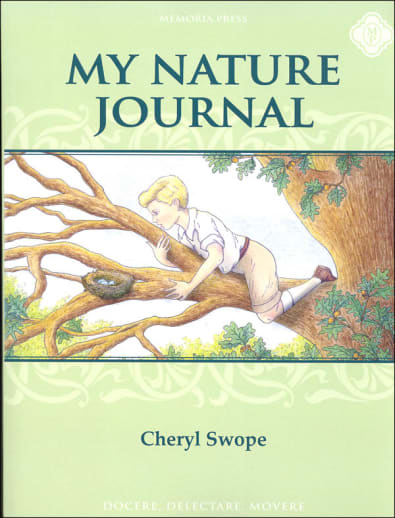Take a walk, find something interesting (a fallen log, a patch of moss, a beetle) and encourage your child/student to take the time to observe, draw and write about what he sees. Each page has 5 large (dotted half-line) writing lines and a space to draw a picture (about 7 x 4) at the top. Younger students can tell you what they see while you write for them and they draw a picture. Older students can write a few sentences on their own. While you are creating a keepsake, children are learning to be curious about nature and practice their handwriting skills. A few pages at the beginning of the workbook explain some classifications children can include and there are some prompts if you need a little guidance on your nature walk. You dont have to find a lush forest; a yard or park will do the trick! Take a magnifying glass and some colored pencils with you. Each page has a verse from a poem or Scripture at the bottom. Memoria Press, 36pp (26 journaling pages), 8.5 x 11 pb ~ Sara
My Nature Journal | Memoria Press
Description
InMy Nature Journal, you will introduce students to the natural sciences through purposeful nature study. Take a walk. Find a patch of lichen, a beetle, or an ant hill, and allow the student time to draw everything he sees. Nudge his drawings with questions provided for you, or create your own to spark attention to detail. "What colors do you see?" "How many legs does the beetle have?" "What shape is the ant hill?"
Each journal page provides a large font space for writing. He may write his own observations, or you can create simple copywork sentences from his spoken words. "He is crawling on the leaf!" or "He looks fuzzy." Find another fact or two from the animal and plant classifications provided for you inMy Nature Journal. "A caterpillar is an insect. Insect have six legs." Record only complete sentences.
When all sentences are recorded on the page, whether dictated, copied, or written, the teacher or student then reads the words aloud. In this manner, you will help the student create a delightful record of his own nature study while cultivating his powers of observation.
| Product Format: | Paperback |
|---|---|
| Grades: | K-3 |
| Brand: | Memoria Press |
| Author: | Cheryl Swope |
| ISBN: | 9781615385331 |
| Length in Inches: | 10.8125 |
| Width in Inches: | 8.4375 |
| Height in Inches: | 0.125 |
| Weight in Pounds: | 0.3 |

